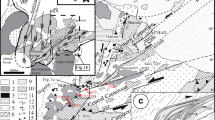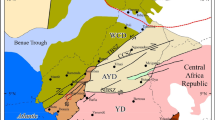Abstract
The Dating rocks and Darjeeling gneisses, which constitute the Sikkim dome in eastern Himalaya, as well as the Gondwana and Buxa rocks of ‘Rangit Window’, disclose strikingly similar sequences of deformation and metamorphism. The structures in all the rocks belong to two generations.
The structures of early generation are long-limbed, tight near-isoclinal folds which are often intrafolial and rootless. These intrafolial folds are associated with co-planar tight folds with variably oriented axes and sheath folds with arcuate hinges. Penetrative axial plane cleavage and mineral lineation are related structures; transposition of bedding is remarkable. This early phase of deformation (D 1) is accompanied by constructive metamorphism. The structures of later generation are open, asymmetrical or polyclinal; a crenulation cleavage or discrete fracture may occur. The structures of early generation are distorted by folds of later generation and recrystallized minerals are cataclastically deformed. Recrystallization is meagre or absent during the later phase of deformation (D 2).
The present discussion is on structures of early generation and strain environment during theD 1 phase of deformation. The concentration of intrafolial folds in the vicinity of ductile shear zones and decollement or detachment surface (often described as ‘thrust’) may be considered in this context. The rocks of Darjeeling-Sikkim Himalaya display minor structures other than intrafolial folds and variably oriented co-planar folds. The state of finite strain in the rocks, as observed from features like flattened grains and pebbles, ptygmatic folds and boudinaged folds indicate combination of flattening and constrictional type strain. The significance of the intrafolial folds in the same rocks is discussed to probe the environment of strain during progressive deformation (D 1).
Similar content being viewed by others
References
Flinn D 1962 On folding during three-dimensional progressive deformation;Q. J. Geol. Soc. London 118 385–433
Gangopadhyay P K 1979 Structural framework of the Daling-Darjeeling-Permian rocks, pp. 23–42. InMetamorphic Rock sequences of the Eastern Himalaya (Ed.) P K Verma (K P Bagchi & Co., Calcutta) 537
Gangopadhyay P K and Ray Sibsadhan 1980 Tectonic framework of the ‘Rangit Window’ around Namchi, south Sikkim;Himalayan Geol. 10 338–352
Gangopadhyay P K and Basu G 1991 Structural characteristics of the rocks of Banihal-Ramban area, Jammu and Kashmir;J. Him. Geol. 2 23–29
Gangopadhyay P K, Sarkar S S and Basu G 1992 Strain analysis using deformed vesicles from Mesozoic Pir Panjal volcanics, Kashmir Himalaya, India;J. Him. Geol. 3 13–19
Gansser A 1964The geology of the Himalayas (New York Interscience, John Wiley) 289 p
Gansser A 1993 Facts and theories on the Himalayas;J.Geol. Soc. India 41 487–508
Ghosh S K 1993Structural geology, fundamentals and modern developments (Oxford: Pergamon Press) 598 p
Hills E S 1963Elements of structural geology (London: Methuen) 483 p
Lal R K, Mukerji S and Ackermand D 1981 Deformation and Barrovian metamorphism at Takdah, Darjeeling, pp. 251–278. InMetamorphic tectonites of the Himalaya, (Ed.) P S Saklani, (New Delhi: Today & Tomorrow’s Printers and Publishers) vol. 4 (Current trends in Geology)
Le Fort P 1975 Himalayas: The collided range, present knowledge of the continental arc;Am. J. Sci. A275 1–44
Mallet F R 1874 Geology of Darjeeling and Western Duars.Mem. Geol. Surv. India 11
Nadai A 1963Theory of flow and fracture of solids. (New York: McGraw-Hill) vol. 2, 705 pp
Ray S 1947 Zonal metamorphism in the eastern Himalaya and some aspects of Geology;Q. J. Geol. Min. Metall. Soc. India 19 117–140
Ramsay J G and Huber M I 1983 The techniques of modern structural geology. Strains analysis (London: Academic Press) vol. 1, 307 p
Saklani P S and Satendra 1986: Strain estimation of Narendra Nagar (Krol) syncline. InHimalayan thrusts and associated rocks (Ed.) P S Saklani, (New Delhi: Today and Tomorrow’s Printers & Publishers) (Current trends in Geology), vol. 9 pp. 71–97
Sinha Roy Subimal 1977 Relation between co-planar folds of variable orientation, stretching lineation and thrust in Daling and associated rocks from the inner tectonic belt of Sikkim Himalaya;J. Geol. Soc. India 18 153–169
Author information
Authors and Affiliations
Rights and permissions
About this article
Cite this article
Gangopadhyay, P.K. Intrafolial folds and associated structures in a progressive strain environment of Darjeeling-Sikkim Himalaya. Proc. Indian Acad. Sci. (Earth Planet Sci.) 104, 523–537 (1995). https://doi.org/10.1007/BF02843414
Issue Date:
DOI: https://doi.org/10.1007/BF02843414




